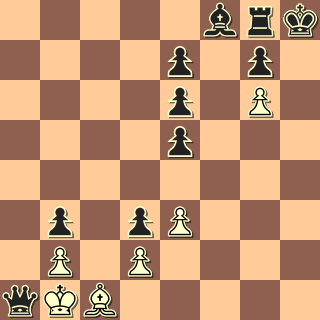
In the above position, the next 7 half-moves (4 white moves and 3 black moves) are forced. Not just strategically forced, but legally forced. On each move, the player on move has only one legal move.
Call this a forced move sequence of degree 7.
Contest: Find a forced move sequence of degree N. Winner is the person who comes up with the largest N.
Contest number two: Find a forced move sequence of degree N, where the final move is checkmate. Same conditions for deciding the winner.
Bill Smythe
Yesterday I had a game where there were 4 checks in a row (ie. white plays check, black reply’s check), it was pretty cool
Care to share?
Was any part of it a forced move sequence of degree N, with N>1?
Bill Smythe
5brk/4p1p1/4PpP1/8/8/1pPp4/1P1P4/KRB5 w - - 0 0
Sorry, not sure how to paste as a diagram.

If you use the quote function on a post with a board already displayed, you will get the characters that went into that board and then you can modify them.
Nice.
Query to the OP: Does this score an 8 or a 10? There is no dispute as to the first eight moves, but a pawn promotion inherently gives a choice beyond the square of arrival (which is forced on moves 9 and 10).
Or, you can go to http://www.jinchess.com/chessboard/composer/, set up the pieces on the screen, and then paste the resulting string to your post inside an img tag.
I think I’d have to count that as only an 8, but it beats mine by 1.
But if, following the promotion, the opponent had only one legal move, and that move captured the new piece, then I think I’d relent and let the promotion count as a forced move.
Bill Smythe
Remove the rooks and pawns on c3, f6 and it becomes infinite.
Not unless the three-fold repetition rule gets repealed.
Removing just the white rook and c-pawn gets to 9.

Good work!

Incorrect. According to the FIDE dead-position rule, and USCF rule 14D4, the game is already over as soon as the diagrammed position is reached.
There is no such thing as a forced move sequence of degree infinity (even without the triple occurrence rule). Any such attempt is actually a forced move sequence of degree zero.
Bill Smythe


